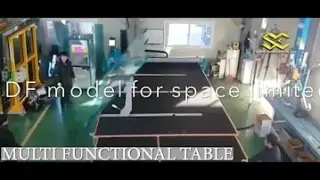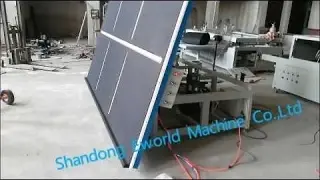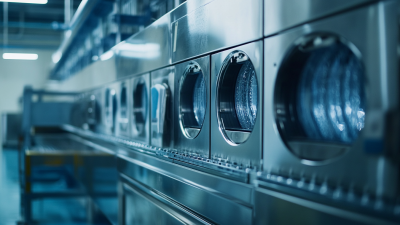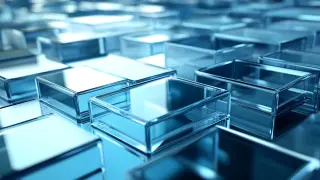It is endless, and the innovative technologies are extremely significant in the enhancement of efficiency and productivity in this rapidly evolving world of manufacturing and fabrication. One of the biggest advancements in this field is the Automatic Glass Cutting Table, which has certainly changed the way glass processing is done. Precision, speed, and reduced material wastage, for this technology, are not just extras but essentials for businesses that want to stay in the market. With accuracy and operational cost as the main focus, it is becoming increasingly important to invest in an Automatic Glass Cutting Table.
At Shandong Evade Machinery Co., Ltd., we understand what it takes to stay ahead in today's competitive market. Our commitment to state-of-the-art machinery and solutions coincides with current trends in automatic glass cutting technology. The Automatic Glass Cutting Tables manufactured by us incorporate advanced features, along with user-friendly design options that guarantee optimum performance. In this blog, we will discuss the best innovations in this field and why those cutting-edge machines are crucial for forward-thinking enterprises that wish to optimize their operations and provide their customers with high-quality products.
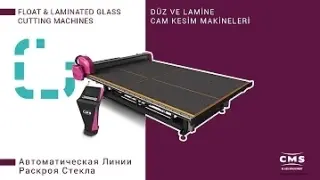
Understanding Automatic Glass Cutting Tables
An automatic glass cutting table revolutionizes the efficiency and precision of glass processing. These machines will thus simplify production processes and improve the quality of finished products. The introduction of advanced technologies, such as automated cutting systems and real-time monitoring, would allow manufacturers to reduce waste and optimize cutting processes to ensure the smooth execution of even the most complex designs. Recent changes in the glass market are emphasizing investment in modern cutting machines. Thus, more and more companies are deciding to upgrade their cutting machines for current glass-processing requirements. Innovations in automated systems, which increase productivity, allow companies to respond quickly to the changing market requirements. Well established partnerships within the industry clearly show that investing in automatic glass cutting tables will enhance operational capabilities and promote competitive standing for future advancement.
Key Innovations Transforming Glass Cutting Technology
Automation in the glass-cutting process is slowly revolutionizing the operations with precision and efficiency for a variety of applications. The latest advancements speak volumes as to whether high-tech cutting tables have enough of a positive impact on productivity, thereby justifying the investment for a company with a competitive outlook. Meanwhile, the companies that were ready to evolve into automated systems have seen tremendous improvements from locating cutting tables toward optimizing workflows and minimizing waste.
For example, modern cutting tables can be integrated into production lines to allow rapid processing of glass from raw to finished product. Thus, the pieces of glass not only cut faster but are also guaranteed to be cut according to specifications and very minuscule margins of error. Such precision is key especially in sectors where quality cannot be compromised, like architecture and automotive applications. Given the rising demand for high-quality glass products, companies that want to increase efficiency and reliability must invest in automatic cutting technology.
Benefits of Investing in Automatic Glass Cutting Tables
The investment in automatic glass cutting tables naturally brings in a lot of benefits to those businesses that wish to improve their productivity and efficiency. This new breed of machinery is here to simplify everything that has to do with glass cutting: decreased wastage, less labor, etc. The latest advancement in this respect naturally gets incorporated with whatever laminated cutting line is currently in place, thereby allowing the enterprise to maximize its output while maintaining quality.
All-in-one suppliers coming into the glass industry mark a transition toward the provision of comprehensive solutions for all production needs. By taking on automatic glass cutting tables, businesses can not only increase their pace of operation but are also highly benefited by way of increased precision and reduced manual handling. With strategic partnerships in the industry evolving, it is good for any company to consider these automated systems to stay competitive and meet the demands of modern manufacturing.
How Automation Enhances Precision and Efficiency
The latest innovation in automatic glass cutting tables is expected to advance significantly in the field of manufacturing and its importance can be felt more by the construction, automotive, and electronics industries. Companies like Kish Glass Ltd are automating processes while increasing the output, which is more of an extension of the current activity. Such companies invest in advanced machinery not only to take their productivity to a new level but also to maintain high-quality production. Consequently, such glass applications boast several uses, from decorative glass items to window techniques and specialized products.
Further, the advancements in technology for glass cutting apply to other industries as well. From these two partners, a host of other reliable production solutions are being made available to manage the increasing demand for quality and intensive factory works. State-of-the-art cutting systems may even bring the production process for windows closer to realizing a growing paradigm for sustainability. Cost-cutting benefits will continue to be complemented by the built-for-automation environment to create a more competitive and innovative market across industrial sectors worldwide.
Comparative Analysis: Manual vs. Automatic Glass Cutting
Automatic glass cutting technology is evolving faster and faster due to innovations that enhance productivity and efficiency. Modern cutting tables and automatically integrating production processes in the cutting shop have led to great cuts in operational turnaround time and processing time. For example, a striking installation has greatly enhanced the flow of operation for one particular glass processor, proving the ability of the advanced machine to act as a transformation tool on production lines.
Another interesting aspect is the introduction of laminated glass cutting tables for constant high-demand glass environments. Designed for the highest possible output, these tools seamlessly integrate with the regular workflow to provide accuracy and speed. The ongoing collaboration among glass manufacturers underlines a fresh spirit of innovation and quality that will keep them nearest to the cutting edge of the industry. By maintaining investments into these crucial technologies, not only are they enhancing their operational capabilities but also positioning themselves well for the demands that are sure to evolve in the market.
Cost Considerations: Long-term Savings vs. Initial Investment
When automatic glass cutting tables are looked at from the investment point of view, one must give thought to long-term savings versus initial expense. Although the initial capital outlay may appear to be very high, it is invariably recovered in efficiency gains during the lifetime of the equipment. For instance, with such advancements in cutting systems, productivity and waste reduction are so important that amount saved can off set the acquisition cost substantially.
Such kind of technology has been adopted by the companies and therefore, it only proves cost saving. These high-end systems streamline the process of production and reduce labor hours, such that companies can have their resources focused elsewhere. While manufacturers continue to introduce newer cutting technologies, it can be a great advantage for companies to embrace these newest glass cutting technologies, proving that such investments are not only costs associated but also a potential avenue for long-term growth.
Industry Applications: Who Benefits from Automatic Glass Cutting?
In the contemporary manufacturing climate, the decision to use manual or automatic glass cutting can make a huge difference in production efficiency. The introduction of automatic glass cutting tables has dramatically transformed the glass cutting industry with precise cuts and their addition for reducing waste while increasing productivity. With the increasing demands for laminated glass, companies need to adopt such advanced technologies to stay competitive.
These advances show that integration into fully automated production lines, as some of the advantages of automatic cutting systems, allows them to provide even more levels of automation combined with labor cost reductions and more safety in the workplace. The companies using innovations in such technologies are achieving amazing changes in processing speed and accuracy. Investing in automatic glass cutting solutions is not a choice but an intelligent initiative to future-proof operations.
Future Trends in Glass Cutting Technology
So, in this period of frantic competition, both big and small business organizations are considering profitable production automation as a way to enhance efficiency and quality. This goes for a manufacturer whom we visited a short while back when it completed the installation of a completely modern cutting table system. This got the final guts out of their work, significantly increasing their output, allowing them to meet customer demand better.
Another case is that of a company that installed new and completely modernized all the machines with precision in glass cutting for possible future growth. Evidence has shown how these businesses invested in automation leading to very high returns while adjusting to the modern production needs. It is about time for experimentation with emerging technologies-a trend that has inevitably evolved from competitive necessity to taking advantage of changes in glass production processes.
In today's thriving market, companies increasingly understand the purpose of production process automation in enhancing efficiency and quality. There's this success story involving a manufacturer who introduced the totally new cutting table system into production. Clearly, it has simplified work dramatically, with a sharp rise in output certainly better meeting customer demand.
Similarly, another company brought in a completely new installation and modernized all previous machines for precision in glass cutting for future development. These have all proven that investment in automation can yield quite high returns as they keep adjusting to modern production requirements. Trying out new technologies is increasingly not just a question of competition but a matter of survival with the changing times in glass-making.
Real-world Success Stories: Companies Thriving with Automation
The promising future of glass cutting technology is brightening with new innovations geared towards higher automation and efficiency. Cutting tables for laminated glass production are specially designed to maximize productivity from an all-included solution cusp. It makes the operation more precise-less waste, better final output.
The increasing investment of firms in automated systems to improve their production lines is indeed observable in this trend. This indeed complements the efforts of glass-producing businesses to integrate seamless cutting processes in the end-to-end supply chain, making their products top-quality and consistent. These improvements really show that mechanization movement is happening in all sectors for manufacturers to contend. The more these technologies are available, the more likely these companies will return substantial investments on those ideas.
Tips for Choosing the Right Automatic Glass Cutting Table
Therefore, when selecting the most appropriate automatic glass cutting table, it is important to factor in the manufacturing needs as well as the features that tend to boost one's efficiency. Automation is one major thing in glass processing today since a high-profile glass manufacturer in Dublin has recently invested in modern automation to increase output and broaden its offering range.
The cutting table should also be assessed for its productivity and integration capabilities. Most of the facilities now implementing new automated systems have noted productivity increases. A company, for instance, has replaced all of the machines that it had ever bought with ones that are supposed to provide accuracy and speed-that might very well mean investing in the latest and greatest equipment to meet market needs. With this level of pace at which this industry is evolving, one investment could very well keep companies ahead.
FAQS
You should weigh the long-term savings against the initial investment costs, as operational efficiencies gained over time often justify the initial expenditure.
Recent advancements in these systems significantly improve production processes and reduce waste, leading to cost savings that can offset the initial price tag.
Companies have reported substantial benefits such as streamlined production processes and reduced labor costs, which allow for more effective resource allocation.
The investment is considered strategic because it positions companies competitively in the marketplace and supports sustainable growth through operational efficiencies.
Consider features that enhance efficiency, productivity, and integration capabilities, which are vital for supporting modern glass processing demands.
Automation can greatly streamline production, improve operational efficiency, and allow manufacturers to diversify their offerings, as seen with a prominent Dublin glass manufacturer.
Upgrading to new systems results in significant improvements in precision and speed, helping companies meet market demands more effectively.
Investing in advanced technology can improve operational efficiency and help companies stay ahead of the competition in a rapidly evolving industry.

Home
About Us
Products
UPVC PVC Window Machine
Aluminum Window Machine
Glass Cutting Machine
Glass Edging Machine
Insulating Glass Machine
Glass lifting machine
Glass Washing Machine
Glass Laminating Machine
Glass Sandblasting Machine
Glass Drilling Machine
CNC Glass Working Center
CNC Non-Metal Cutting Machine
The Other Glass Machinery
Application
Download
News
Contact Us

